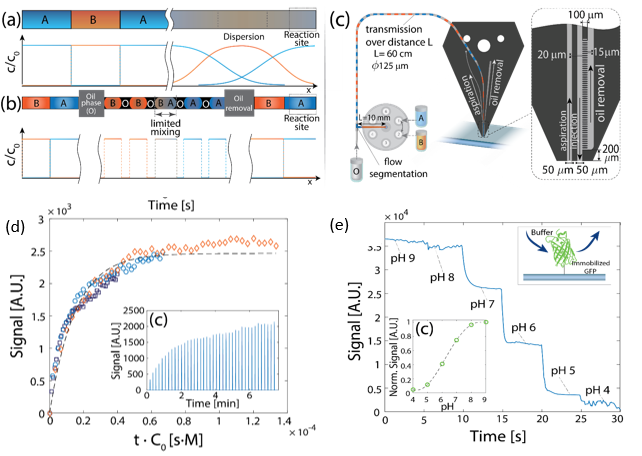Microscale biopatterning on surfaces with hydrodynamically confined liquids on a scanning probe
Patterning and immobilization of biomolecules on surfaces are central to surface biological assays. We present a novel method which allows contact-free sequential delivery of reagents to a reaction site on a surface, with a characteristic switching time of 560 ms over a transport distance of 60 cm. We use a standard off-chip selection valve to switch between reagents, which are immediately encapsulated as droplets in an immiscible liquid. The droplets confine the dispersion between reagent interfaces, and are delivered to a microfluidic probe head. This confined flow can be brought into contact with any surface, including cell tissues, to drive a reaction. In close proximity to the apex, we implemented a passive phase-separation microstructure that allows complete removal of the oil phase, such that only the aqueous phase exits the chip and reaches the reaction surface. The separator consists of an array of capillaries, which are subjected to a negative pressure and, owing to hydrophobicity differences between phases, allow removal of the continuous phase, such that only the aqueous phase reaches the reaction surface. With this we demonstrate two key applications of the method for measurements of receptor-ligand reaction kinetics and protein response to chemical stimuli. We believe the method will be useful for studying the dynamic response of cells and proteins to various stimuli, as well as for highly automated multi-step assays.

Figure 1: Schematic illustration of the operation principle and applications which allows sharp interfaces to be maintained between individual plugs over long distances and applied on a surface using a MFP.
[1] J. Autebert, J. Cors, D. Taylor, and G. V. Kaigala, Anal. Chem. 88(6), 3235–3242, 2016.
[2] N. Ostromohov, M. Bercovici, and G. V. Kaigala, Lab Chip 16, 3015–3023, 2016.